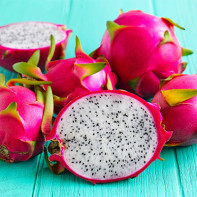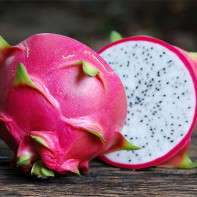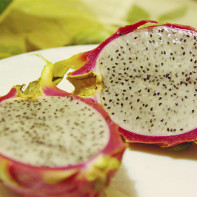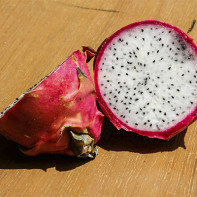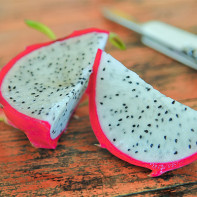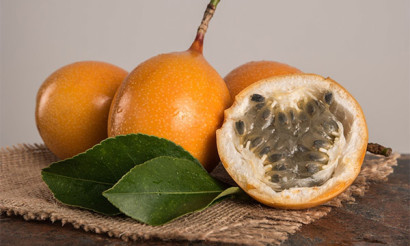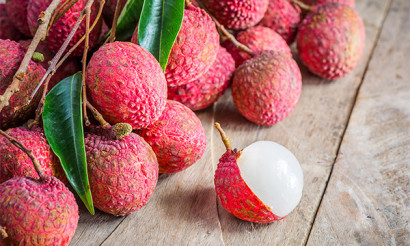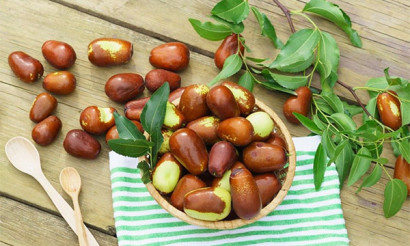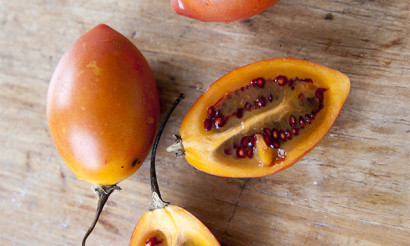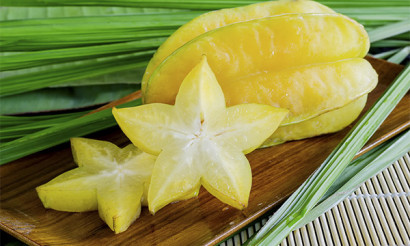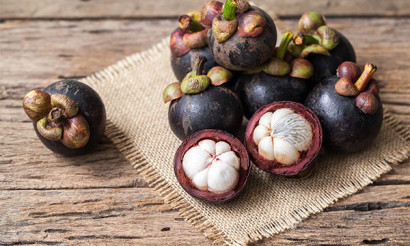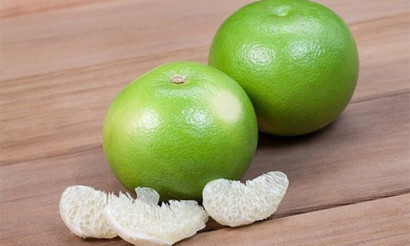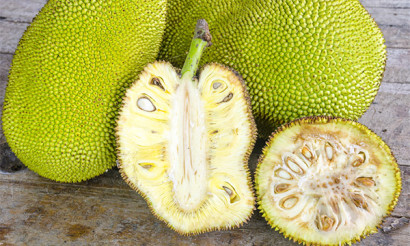Pitahaya (dragonfruit): health benefits and contraindications
This plant has many names - pitahaya, pitaya, "dragon fruit". Its fruits do not look too appetizing - they resemble large pink cones. But in fact the white flesh of this fruit has a rather pleasant taste. And, according to scientific studies, it is also very useful.
- What is a pitahaya
- Types
- What it looks like and where it grows
- What does the dragon fruit taste and smell like
- Composition and calories
- Useful properties of the fruit dragon fruit
- General benefits
- For Women
- For Men
- If Pregnant
- Breastfeeding
- For children
- Slimming
- Fruit Usage
- In medicine
- Cosmetology
- Culinary
- Hazards and Contraindications
- How to Choose and Store the dragon fruit
- How to eat dragon fruit
- How to peel it
- Is it possible to grow dragon fruit at home?
- Interesting Facts
What is a dragon fruit?
This fruit looks like representatives of alien flora. But in fact, they are the fruit of plants from the Cactus family. They have an unusual appearance. They are creeping plants with airy roots that look more like vines. They can be up to three meters long. Some species have soft prickles while others have none at all. They all bloom with very beautiful large flowers, most often white or cream colored.
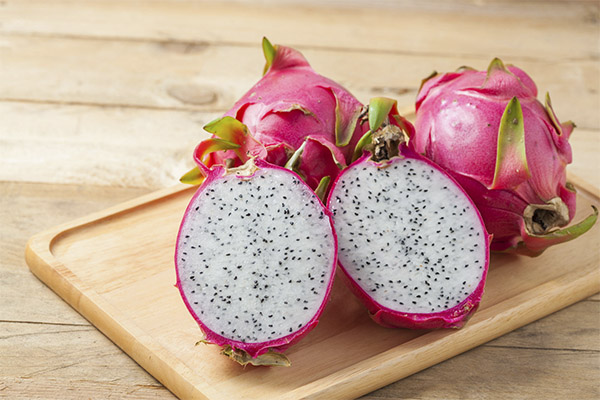
Types
There are several species of pitahaya, and they differ not only in hue but also in taste:
- Costa Rican Pitahaya is the fruit of the cactus Gilocereus costaricana, which grows in Guatemala and Peru. This variety is said to have the most neutral flavor, with some defining it as bland or even grassy. These fruits are often used to make salads. They also go well with other dishes, but only without a distinct flavor.
- The red pitahaya is the fruit of the cactus Hylocereus wavy (or twisted) with a brighter rind and flesh. It has the most intense flavor and aroma (compared to other varieties).
- The yellow pitahaya is the fruit of a cactus called Hylocereus large-flowered. It is often cultivated just for decorative purposes, as it has almost the largest flowers in the whole family. The fruits have yellow skin and their flesh is considered the sweetest.
All varieties have a rather juicy pulp. But it should be noted that red pitahaya is less common on the market because it is more difficult to cultivate.
What it looks like and where it grows
The fruit of the pitahaya resembles a cone - it has an elongated shape, often close to an oval. The weight of the fruit can range from 160 to 600 g, but sometimes larger fruits, up to 850 g (and some sources claim up to 1 kg), are found. The size of the fruit depends on the variety and cultivar, as does the color of its flesh. The skin is smooth on the whole, but it bears a characteristic leaf-like outgrowth, resembling frozen tongues of fire, which was probably the reason for its name, the dragonfruit.
Although the name dragonfruit refers to more than one plant, they all share a common trait. They grow in regions with arid tropical climates. For example, the dragon fruit has long been known in Mexico and Hawaii, and is widely grown in Southeast Asia, such as China, Thailand, Vietnam, etc. And nowadays it is also grown in Israel.
What does the dragonfruit taste and smell like?
The taste of this fruit can only be described in comparison to others. While its creamy texture resembles figs (although it does not have as pronounced an aroma), the taste of the most common varieties can be compared to kiwi. The yellow pitahaya tastes a bit like a banana.
Composition and calories
The energy value is low. In 100 g of pulp contains only 50 kcal, which makes it one of the most useful dietary products.
As for the chemical composition of the fruit, they contain B vitamins, specifically:
- Thiamine (B1) is a vitamin that participates in various metabolic processes, improves the body's ability to fight infectious diseases, normalizes the level of acidity of gastric juice, provides motility function of the intestines.
- Riboflavin (B2) is one of those vitamins without which normal hormone production is impossible. In addition, it is essential for good vision, because it protects the retina from the negative effects of sunlight, improves adaptation to the dark.
- Niacin (B3) is a vitamin that is actively involved in lipid and protein metabolism. In addition, it is essential for normal functioning of the stomach and pancreas.
Ascorbic acid (vitamin C), which has antioxidant activity, is part of this fruit. Separately, we should highlight such substances as betacyanins and betaxanthins - they are also antioxidants with pronounced anti-inflammatory properties. The pulp also contains essential elements such as vitamin PP, iron, potassium, and phosphorus.
Useful properties of the dragon fruit
General benefits
Numerous studies have shown that the dragon fruit is a very useful fruit, as it has beneficial effects on the cardiovascular and endocrine systems. In this case, the medicinal properties possess both the pulp of the dragon fruit and its seeds. They contain tannins, which are good for eyesight, so it is worth to eat the pulp and seeds at least for the prevention of myopia and hyperopia.
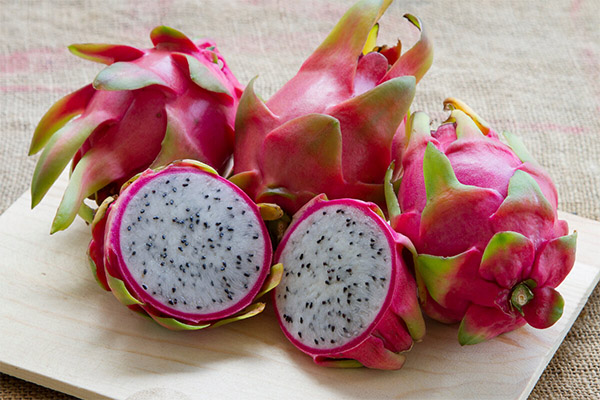
In addition, there are studies that confirm the benefits of the dragon fruit for diabetes. Its constituent fiber helps to improve digestion and normalize bowel function.
For women
Very often the dragon fruit gets attention because of the fact that it contains a lot of antioxidants. Indeed, such substances help to significantly slow down the aging process of the body, particularly the appearance of wrinkles. But for women, the dragon fruit is also useful because it contains a lot of calcium (one fruit contains a daily allowance of this substance). And this is very important for women during menopause, because at this time, the lack of calcium can lead to osteoporosis.
For men
As we know, antioxidants have, among other things, anti-inflammatory properties. This is why the dragon fruit is also useful for men. Its antioxidant content is an excellent preventive and therapeutic agent against prostate diseases.
Pregnancy
Future mothers can benefit from the pitahaya for several reasons. For example:
- The flesh contains a lot of iron, and this element is necessary for the production of red blood cells (red blood cells). During pregnancy, when a lot of resources are spent on the development of the child's body, women face anemia. Consumption of pitahaya avoids this problem.
- This fruit contains a lot of folic acid, a vitamin that is necessary for the normal development of the fetal nervous system.
- The fiber contained in the pulp should normalize digestion and eliminate bloating, another problem faced by young mothers.
However, you should use this product with caution, because it can cause a strong allergic reaction.
When breastfeeding
During the lactation period, young mothers need vitamins. However, from pitahaya in this case, it is better to refuse, as the baby's body can react negatively to any potential allergens, even in more familiar products.
For kids
As a treasure trove of vitamins, the dragon fruit is very good for children. But we must remember that just like all other exotic fruits, it can cause severe allergies. It is generally contraindicated for preschool children. Children of seven years of age it is already possible to give, but not more than one fruit per day.
When losing weight
It is believed that the dragon fruit helps to get rid of excess weight. Indeed, the pulp of this fruit contains fiber, which helps to normalize the digestive process, and this is the basis for proper metabolism. In addition, the dragon fruit contains B vitamins that help speed up the metabolism.
This fruit can be used in different ways in dietetics. The most common option is a day of unloading on the basis of the dragon fruit. Most often, smoothies based on this fruit are prepared for this purpose.
For example, in the season of strawberries you can arrange a day of unloading on such a smoothie. Take the pulp of one medium dragon fruit, 200 g of fresh strawberries, 30 g of cashew nuts and about 70 ml of coconut milk. All these ingredients are whipped in a blender until a homogeneous mass of fairly liquid consistency. The smoothie is prepared immediately before consumption. On the day of discharge you can drink three of these smoothies, other food in your diet should not be.
This time you should choose one more variant, which can be made at any time of year. For this purpose you should take the pulp of one dragon fruit, 100 grams of peeled pineapple, two medium-sized bananas, a small piece of ginger root (up to 2 cm) and 100 ml of boiled water. Grind all these ingredients in a blender. If the fruit itself is not very sweet, you can add a little honey to the drink. You can drink no more than three glasses of such a smoothie per day.
Application of the fruit
Due to its low calorie content and rich vitamin composition, the fruit is used not only in cooking, but also in dietetics, folk medicine and cosmetology. For example:
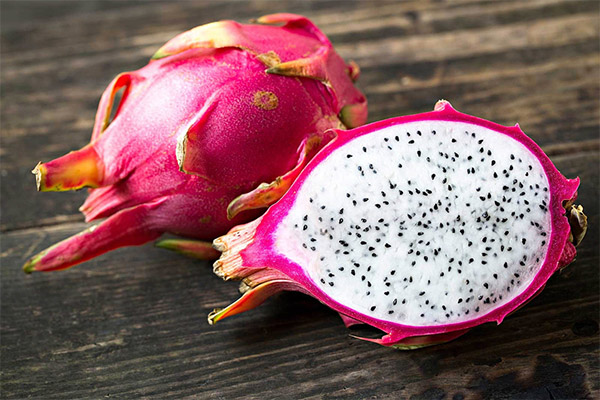
- The pulp of the fruit helps with stomach pain, as well as some thyroid disorders.
- The juice of the fruit has not only anti-inflammatory but also antimicrobial effects, it can be used to treat any inflammatory processes on the skin. It is also considered effective in the treatment of arthritis.
- The seeds contain a whole complex of substances that can improve the condition of people suffering from diabetes.
All parts of the plant are useful. In Southeast Asian countries, both freshly cut stems and flowers are used (the latter can be brewed with tea).
In medicine
In Russia, the pitahaya is not used in official medicine, in the folk tradition too (this is not surprising, because this plant does not grow here). It is used mainly in traditional medicine of Eastern countries, especially popular in Thailand. Here they offer the following variants of its application:
- With urolithiasis, it is recommended to make decoctions from the flowers (10 g of dry raw materials per glass of boiling water). This remedy has diuretic properties.
- With helminthiasis also make decoctions from the flowers and leaves of the plant.
- If you have arthritis or other inflammatory diseases of the joints, you can make compresses on the basis of the pulp and juice of dragon fruit or just include this product in your diet, but no more than 1-2 fruits per day and only after consulting your doctor.
- If you have burns on your skin, you can make a lotion from equal parts dragon juice, cucumber juice, and honey. This lotion will draw heat away from the affected area of the skin and greatly alleviate the condition, including sunburns.
- For gastritis in remission, it is recommended to include in your diet puree of the pulp of one dragon fruit (best to take it once a day on an empty stomach).
The dragon fruit is also recommended for liver diseases, enterocolitis, and cardiovascular diseases.
As for eating the dragon fruit for diabetes, doctors are still divided on the benefits of the fruit. There have been a number of studies, which show that regular consumption of the fruit pulp can stabilize blood sugar levels in type 2 diabetes. But you should only eat the fruit with the seeds. And at the same time, studies have shown that the best result is obtained by eating on an empty stomach, because only in this case you can effectively stimulate the activity of those cells of the pancreas that are responsible for the production of insulin.
Important: The glycemic index of the pitahaya is 25 units.
In cosmetology
Pitahaya is good because it benefits all skin types. Extracts of this fruit are added commercially to any facial care cream. At home, you can make skin masks:
- For oily or problematic skin. The pulp of the fruit is whipped in a blender, 2-3 drops of tea tree essential oil is added, stirred and the mixture is applied to the face, avoiding only the more sensitive area around the eyes. The mask is left on for 15-20 minutes and then is washed off with cool water or herbal decoction.
- For normal skin. The pulp of a fruit is whipped in a blender like in the previous recipe, but essential oil of rose or any citrus fruits is added. Leave the remedy for 15 minutes, then rinse thoroughly with still mineral water.
- Against acne. Pythaya contains vitamin C, antioxidants and other substances with antimicrobial activity, so it is effective against acne. To do this, simply cut the fruit into slices and apply them to the affected areas of skin on the face for literally 15 minutes. Then these slices are removed and the face is washed with warm water. For maximum results, the procedure is repeated twice a day, morning and evening.
The dragon fruit can also be used to prepare scrubs for the body and face. In this case, the seeds themselves should act as an abrasive (i.e. scrubbing) agent. For the face is recommended a finer degree of grinding. So, the pulp and seeds in this case should not be kneaded by hand, but in a blender. If desired, you can add additional ingredients. For example, lemon juice will give a whitening effect.
Pitahaya is also used for hair care. For example, it is believed that its juice will help restore dyed curls. To do this, you can use one of two recipes. For example, you can simply add the freshly squeezed juice to the hair conditioner every time you wash your hair. This will help to cleanse the scalp, saturate the hair follicles with beneficial substances, will contribute to the restoration of curls - they will become soft and silky.
The second option - once a week to make a mask. To do this, the pulp of one fruit is scraped with a spoon and crushed in a blender until a homogeneous mass. The resulting puree is applied to the scalp, put on a plastic cap and wrapped with a warm terry towel. The product is kept on the skin for 15-20 minutes, then washed with a normal shampoo (but preferably without silicones and parabens). This mask can be enriched with vitamin E, adding to the mixture one capsule, which helps to improve the structure of the hair.
In Cooking
The dragon fruit is used mainly for making desserts, and it is used in a raw form, because heat treatment destroys the vitamins and removes its flavor. And in Thailand, the dragon fruit is most often consumed as a separate product, in Vietnam they come up with desserts based on it, and in Indonesia, alcoholic drinks with the dragon fruit are popular.
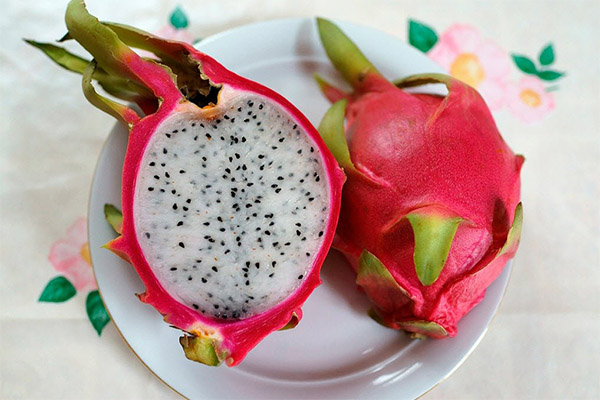
For Russian housewives, the dragon fruit remains exotic, but you can use not the traditional oriental, but modern recipes adapted to European cuisine. For example:
- Fruit salad. For its preparation you will need: 2 pitahaya fruits, 1 mango fruit, 50 g blueberries, ½ kiwi fruit, 3-4 strawberries. There are two ways to prepare this dish. You have to peel the dragon fruit and mango, cut them into cubes and add a peeled and sliced kiwi. The whole thing is garnished with whipped cream and berries. Another variant: diced mango and kiwi slices are poured over mashed dragon fruit puree and garnished with berries.
- Sorbet. To make it you need 2 medium-sized dragon fruit, ¾ cup cold, purified water, 1 tbsp freshly squeezed lemon juice, 2 tbsp sugar. Peel the dragon fruit, cut it into pieces, add lemon juice, sugar and water, and mix it in a blender until smooth. After that the mixture is frozen in order to form ice crystals. Do not throw away the rinds of the pitaya. The peels are used to make sorbet sticks, which are then deposited in the sorbet.
- An American dessert with almonds. To prepare it you take two dragon fruit, 50 gr. almonds (to grind them first) and 100 gr. of soft cream cheese similar to the one to make cheesecake. If you would like to cut the pita bread into cubes, whip the cheese with a whisk and add 2 tablespoons of condensed milk, then finely chop the almonds and the pita bread cubes and gently mix them. Serve the dessert in dragon fruit rind boats.
- A healthy breakfast. To make it you need 3 small dragon fruit, 2 tablespoons of cane sugar, ¾ cup water, 1 tablespoon each of goji berries, chia seeds and coconut, 2 tablespoons of cereal or granola, any fresh fruit. Chop the pitaya pulp in a blender, add water and sugar, put it in the freezer for no longer than 15 minutes, then add the rest of the ingredients, mix and serve. You can freeze the dessert completely. In this case you have to keep the pureed dragon fruit in the freezer until the ice crystals form and then decorate it with the rest of the ingredients.
You can also make alcoholic drinks, such as cocktails, on the basis of pitaya. To make it you need 1 peeled dragon fruit, 100 ml of vodka, 1 tbsp fresh squeezed lime juice, 2 tbsp cane sugar and 50 ml of coconut milk. All this is mixed in a cocktail blender.
Harms and contraindications
Pitahaya for all its advantages has one very significant disadvantage. This is an exotic fruit, and therefore there is a very high risk that it will provoke a strong allergic reaction. Therefore, even if the person has never had an allergy before, he will have to use the dragonfruit with caution. That is, at first you need to eat a small amount of pulp, and only then, if after a couple of hours no manifestations of allergy occurred, you can eat the whole fruit. In principle, and in the future should adhere to these limits - 1-2 fruits a day, no more.
At the same time, sometimes when using red varieties of urine and feces may take on a reddish hue. There is nothing wrong with this, it's just the way the body processes the natural pigment.
Small children under the age of 7 should not eat dragon fruit at all, because it can lead to diathesis. For the same reason, this fruit should not be included in the diet of pregnant women.
In addition, you should consider that in people who suffer from diarrhea, eating this fruit can significantly aggravate the problem.
How to choose and store the dragon fruit
It is very important to choose the right fruit - only then will they be beneficial. The choice of dragon fruit should be guided by its appearance. But since these fruits are exotic to the Russian market, not everyone knows how they should look.
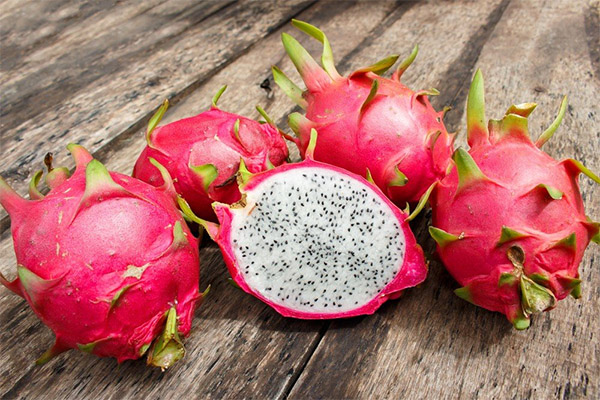
So, although there are several varieties of dragon fruit, its rind should be pink in any case. But the color of the flesh can be different, either white or dark, with a crimson cast. However, there is another unusual variety - yellow dragonfruit. Its fruit is distinguished by its yellow rind and light flesh. The seeds in all of these varieties should be dark and small, like poppy seeds.
You should choose a fruit with a bright pink rind and no spots on the surface. If the rind is too pale, it indicates that the fruit is not yet ripe. If there are dark spots on the surface - the fruit is overripe. In addition, you should be guided by the tips of the outgrowths of the "dragon fruit". Ripe fruits should have yellowish green tips. Dry and shriveled "scales" suggest that the dragon fruit is overripe and has been picked a long time ago. But if you do happen to pick such a ripe fruit, don't throw it away. You can collect seeds from it and grow this cactus at home.
It should also be noted that overripe fruits are always too soft. This can be understood by gently pressing with your finger on the fruit. Its surface should only give way slightly - like an avocado. If the dragon fruit is a bit unripe, you should leave it in the fridge for a couple of days. But you should not leave it for too long. The fresher they are, the more nutrients they contain.
Store these fruits in the refrigerator, but unfortunately, these tropical fruits can not lie for a long time even there - 5-6 days maximum.
How to eat the dragon fruit
The main rule here is one - eat only the flesh of the fruit. The top layer is considered inedible. Nevertheless, the dragon fruit should still be washed under running water, after which it should be dried with a paper towel. After that you clean it with one of the methods described below. As for eating the pulp, there are no strict rules, but in Thailand, for example, it is customary to serve it chilled. In addition, there are very sweet varieties, for Europeans they may even seem cloying, so it is recommended to sprinkle such fruits with lemon juice.
How to Peel
There are several ways to get rid of the top layer. For example:
- Pitahaya can be peeled, starting at the top, as is done with a banana. Then only the dense pulp will be left on the plate.
- Slice like an orange and peel each one separately.
- Cut like a kiwi, into two halves, and remove the pulp from each with a spoon.
If you want to use the dragon fruit for a salad, you need to cut it in half, gently pull out the pulp and cut it into cubes. The skin should not be thrown away. It forms beautiful "boats", which can be filled with sliced fruit cubes for the salad.
Is it possible to grow pitahaya at home
At home, you can grow pitahaya from those black seeds that are in the white pulp. As already noted, they contain many beneficial substances and can be used in folk medicine. But you can also grow your own flower from them.
The pitahaya is essentially a cactus, so it will grow just fine at home. In general, it is an undemanding plant, so no special conditions need to be created for it. Pythaya likes well-lit areas and warmth, but it can also tolerate some lowering of temperature (for short periods - down to zero). It will also survive occasional blackouts.
So, to grow at home you need to collect seeds. Then germinate them in damp gauze. When they give sprouts, then transplant them into a small container with soil and put them on a window sill in a bright room. While the shoots are only strengthening, it is worth organizing a mini greenhouse, covering the container with polyethylene film. But in general, the shoots very quickly get out of the soil and grow quite actively - in a year they can reach a height of 80 cm. All this time the plant needs regular, but at the same time moderate watering. For a lush flowering it is necessary to apply nitrogen fertilizers. However, it should be understood that at home, without insect pollinators, the plant will not produce fruit. Therefore artificial pollination will have to be applied. This requires the growth of at least two specimens of blue dragon plants. They will need to be pollinated with a soft brush, at night, because that is when these magnificent flowers open.
Interesting Facts
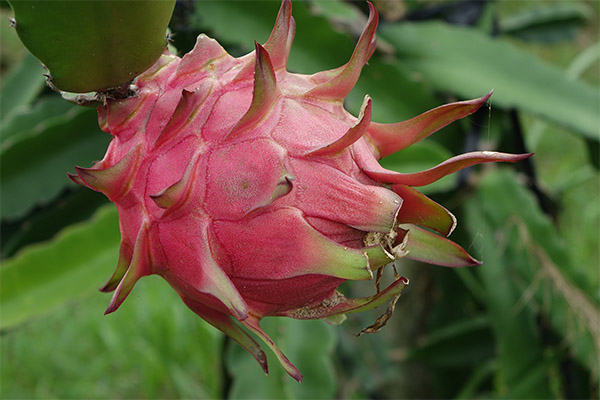
The homeland of this crop is Central America. It is believed that already more than 700 years ago the dragon fruit was familiar to the Aztecs. Europeans were introduced to it already in the era of the Great Geographical Discoveries, when these fruits were tasted by conquistadors. However, to bring pitaya to Europe at that time would have been very difficult, because it is not stored for a long time. But in 1870 the plant came to France from its overseas colonies. At that time, it was cultivated to decorate gardens.
Today, the dragon fruit is grown for export in Vietnam, Nicaragua, and Colombia, and it is also cultivated commercially in Israel. A harvest of 30 tons per season can be obtained from 1 hectare. Not all of this amount is used for culinary purposes. The stems and flowers are used in the pharmaceutical industry, the pulp and peel - in perfumery. In some countries, this plant is also a supplier of raw materials for the alcohol industry - from it prepare, for example, liqueurs.
«Important: all information on the site is provided solely for introductory for educational purposes only. Consult with a health care professional before using any of our recommendations. specialist before applying any of the recommendations. Neither the editors nor the authors shall be liable for any possible harm caused by materials."

